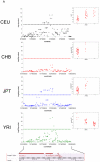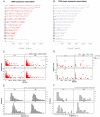Relative impact of nucleotide and copy number variation on gene expression phenotypes
- PMID: 17289997
- PMCID: PMC2665772
- DOI: 10.1126/science.1136678
Relative impact of nucleotide and copy number variation on gene expression phenotypes
Abstract
Extensive studies are currently being performed to associate disease susceptibility with one form of genetic variation, namely, single-nucleotide polymorphisms (SNPs). In recent years, another type of common genetic variation has been characterized, namely, structural variation, including copy number variants (CNVs). To determine the overall contribution of CNVs to complex phenotypes, we have performed association analyses of expression levels of 14,925 transcripts with SNPs and CNVs in individuals who are part of the International HapMap project. SNPs and CNVs captured 83.6% and 17.7% of the total detected genetic variation in gene expression, respectively, but the signals from the two types of variation had little overlap. Interrogation of the genome for both types of variants may be an effective way to elucidate the causes of complex phenotypes and disease in humans.
Figures




References
Publication types
MeSH terms
Grants and funding
LinkOut - more resources
Full Text Sources
Other Literature Sources
Molecular Biology Databases
Research Materials

